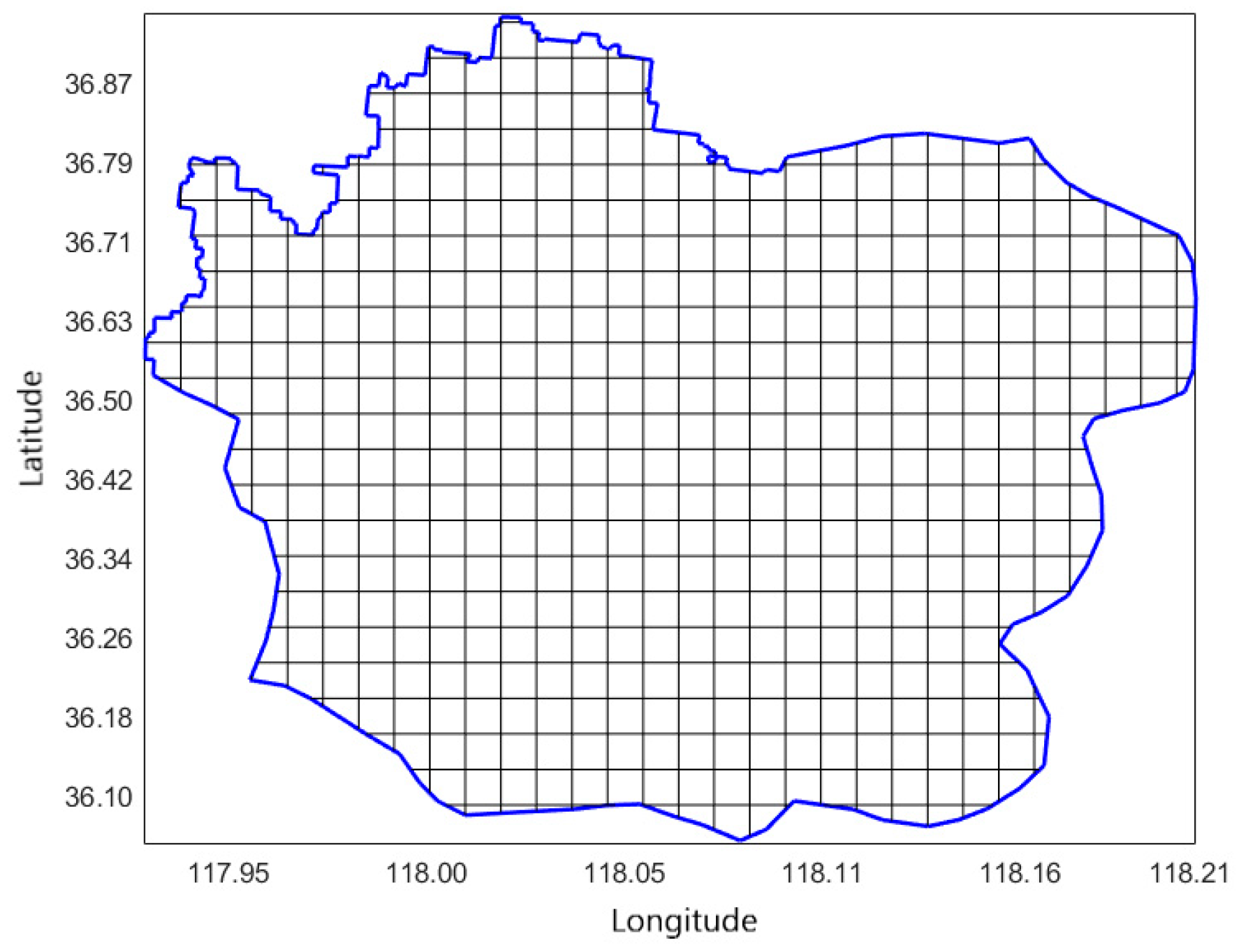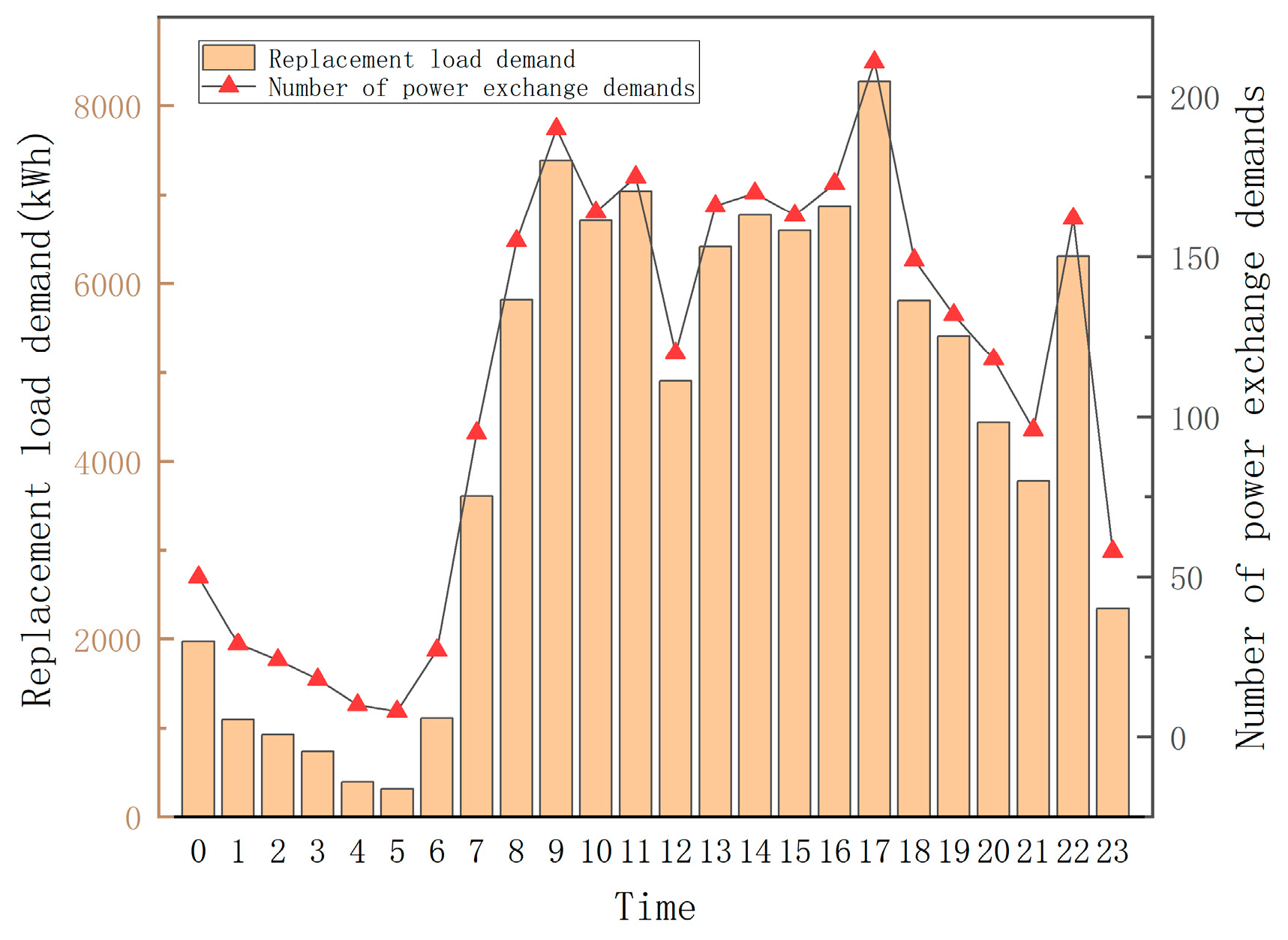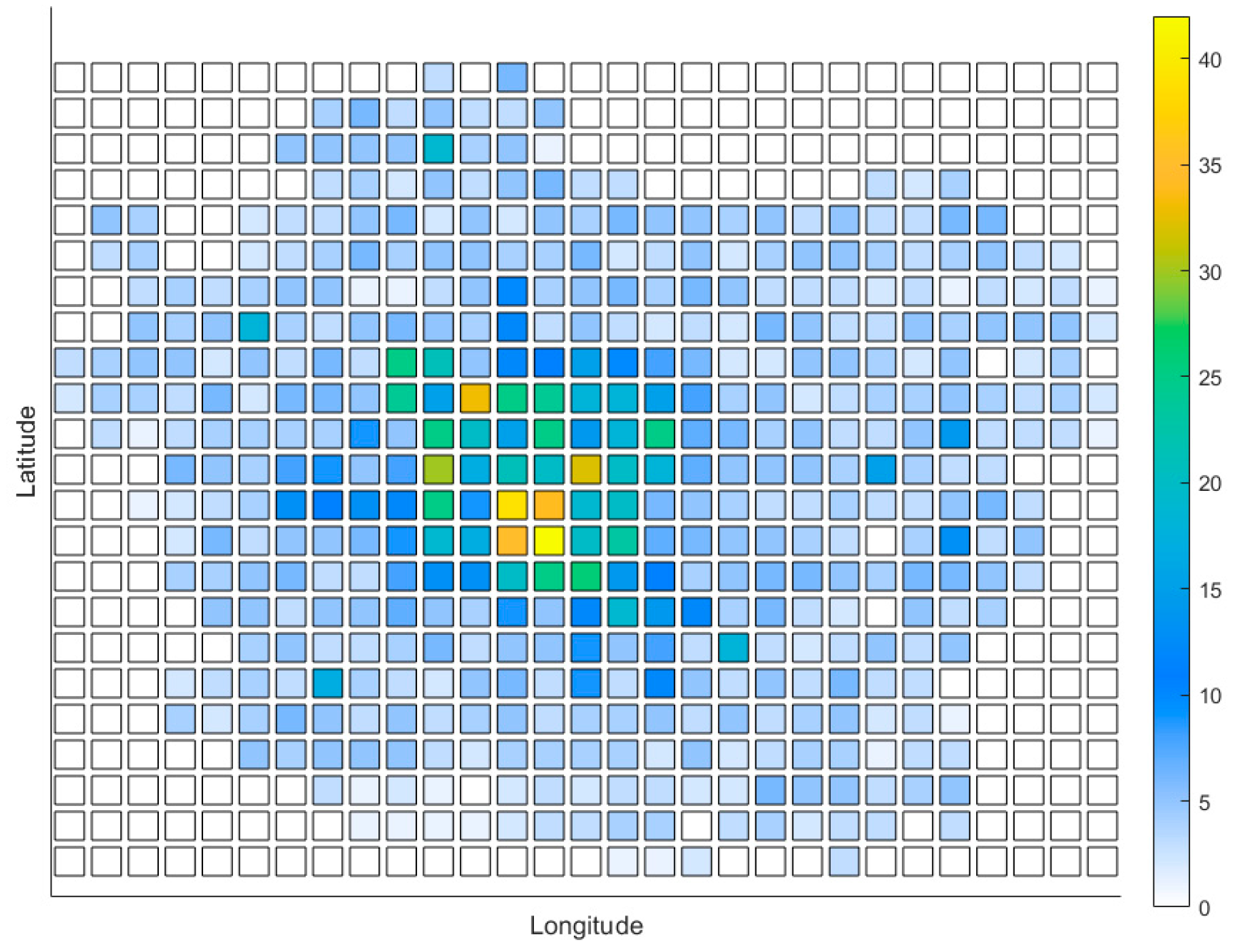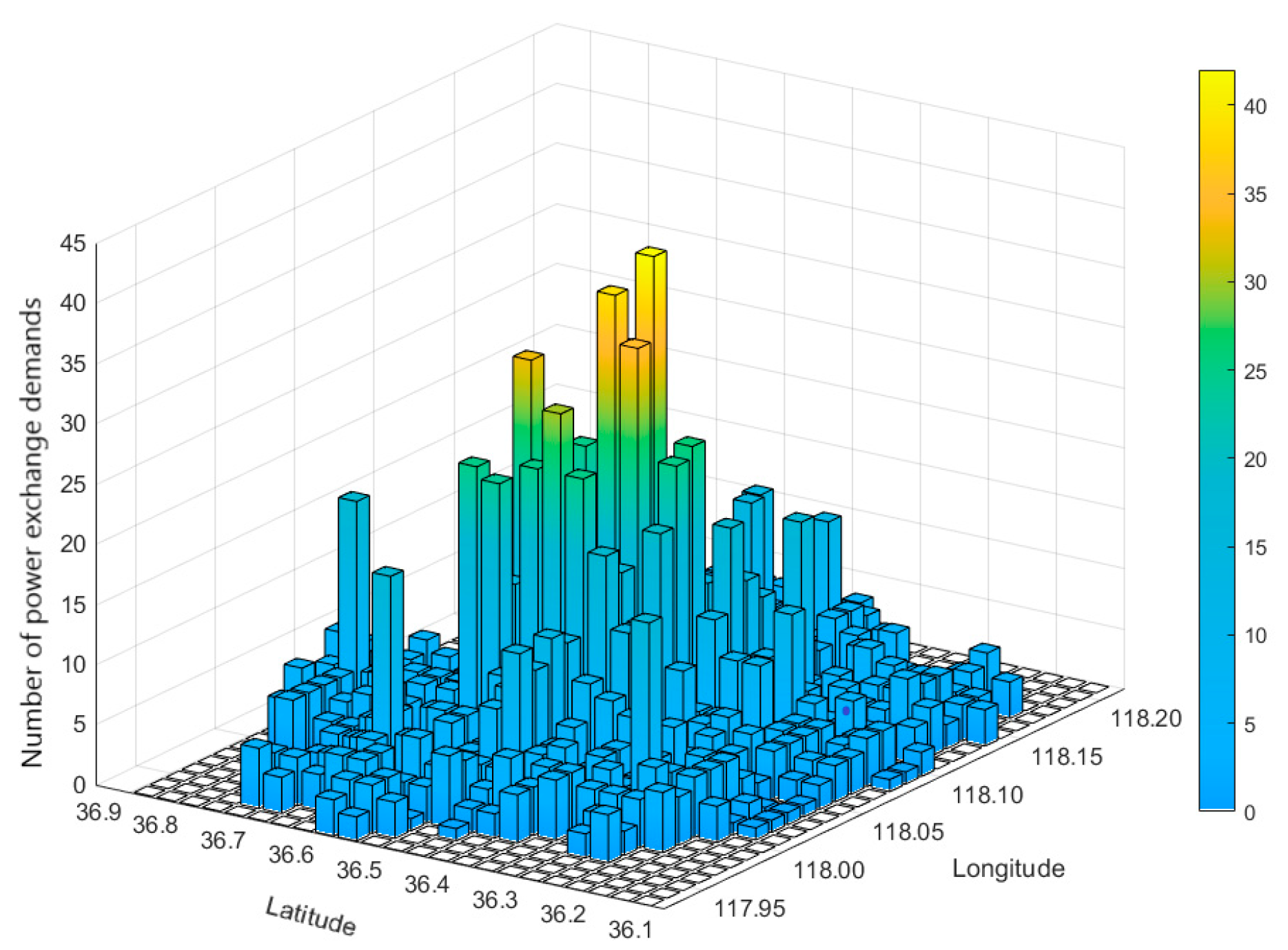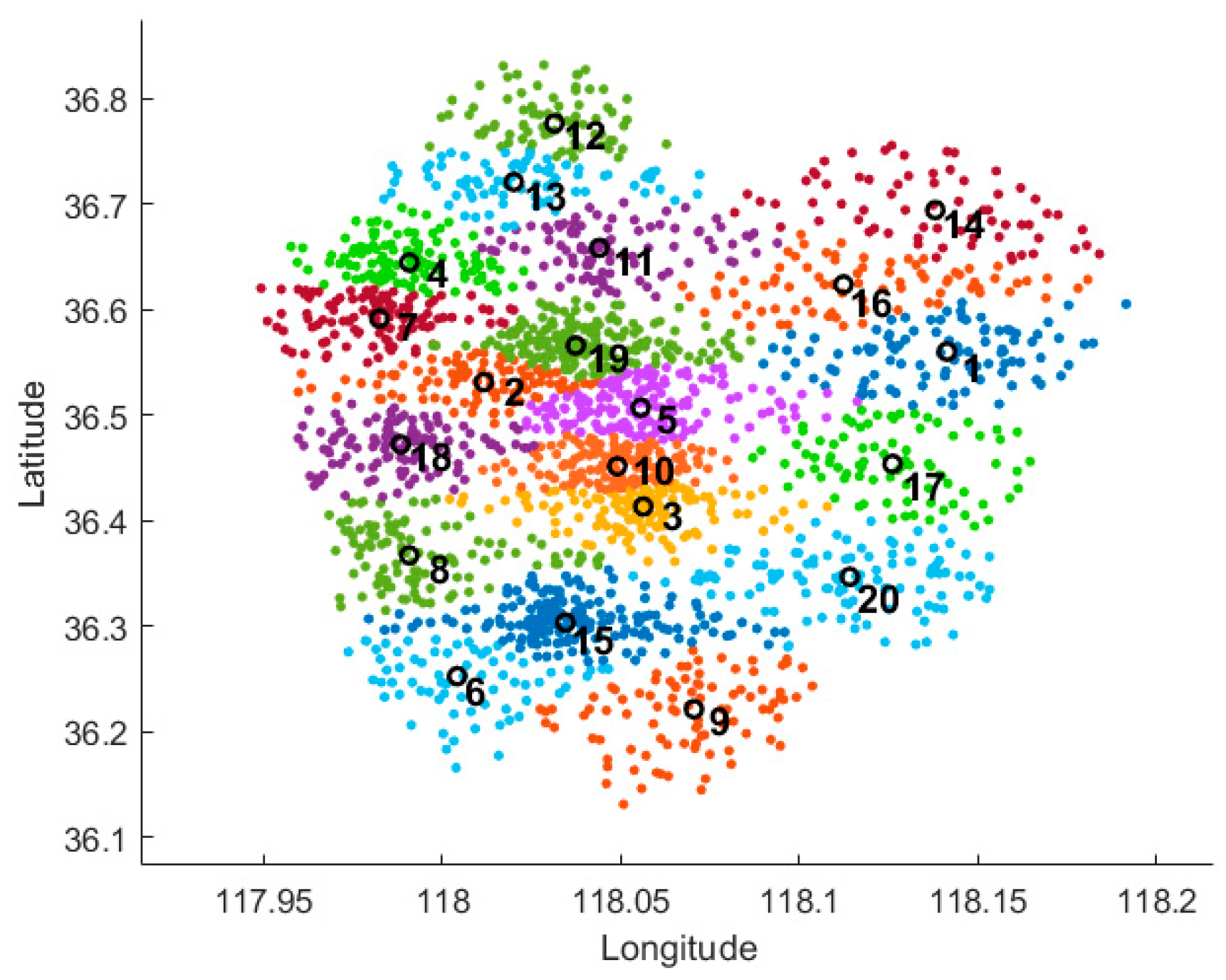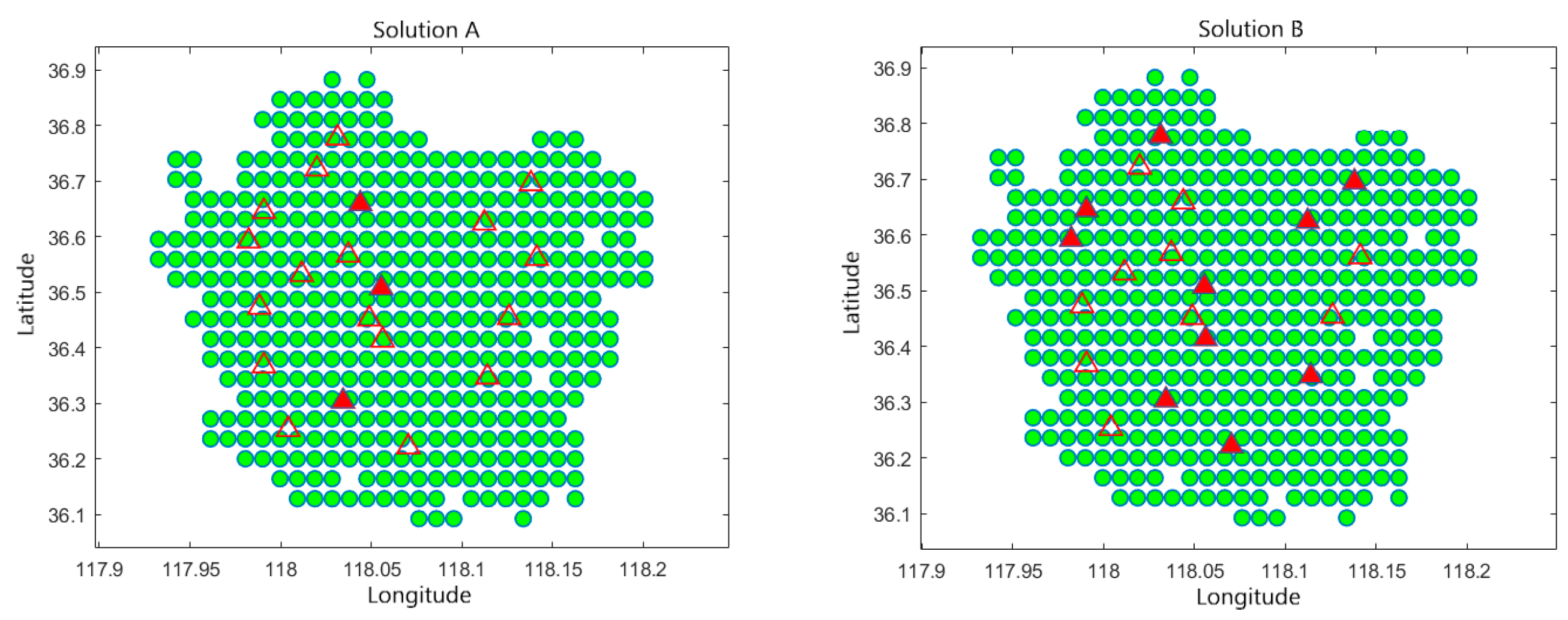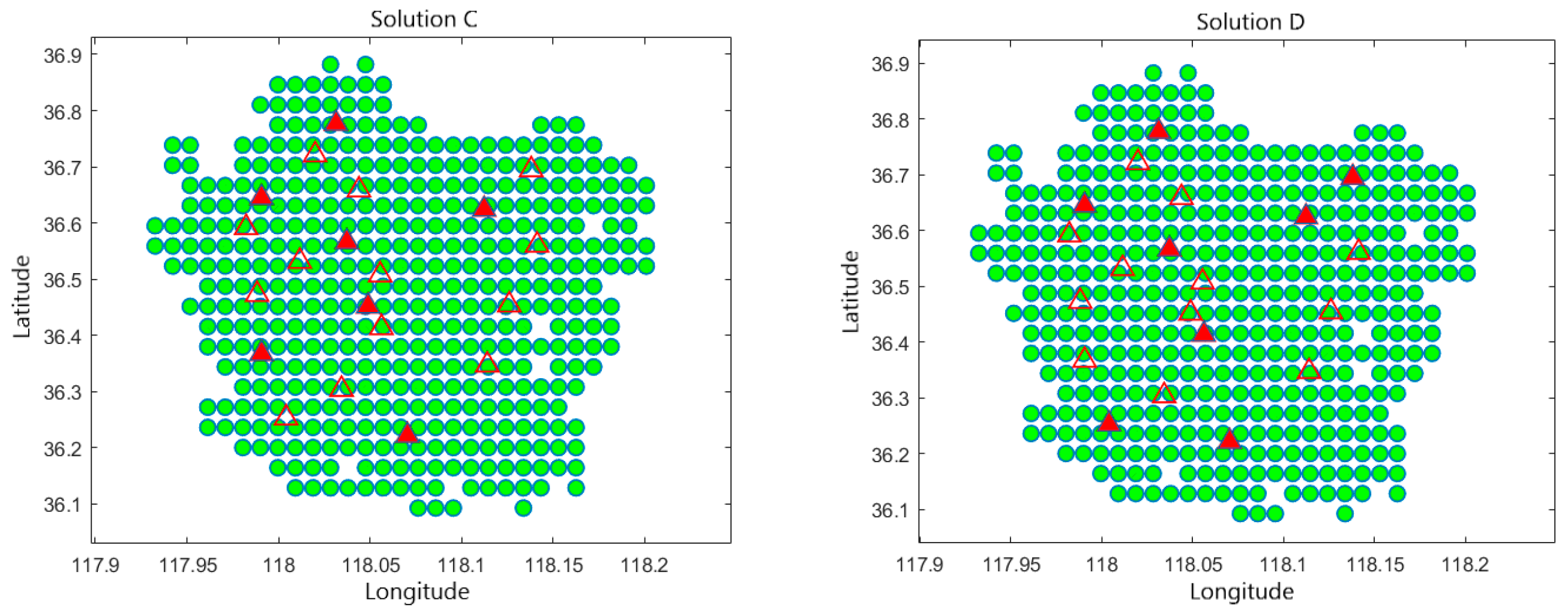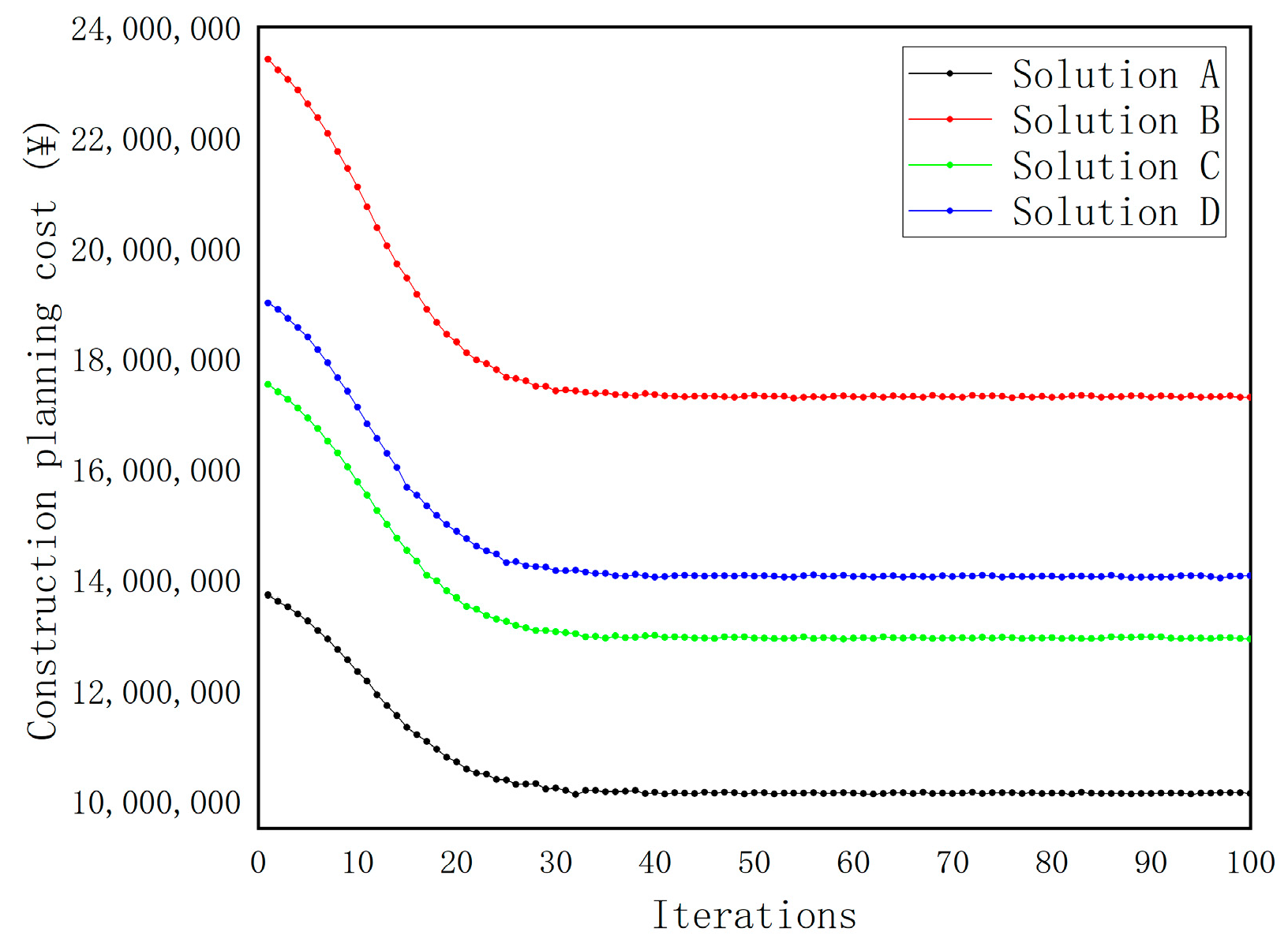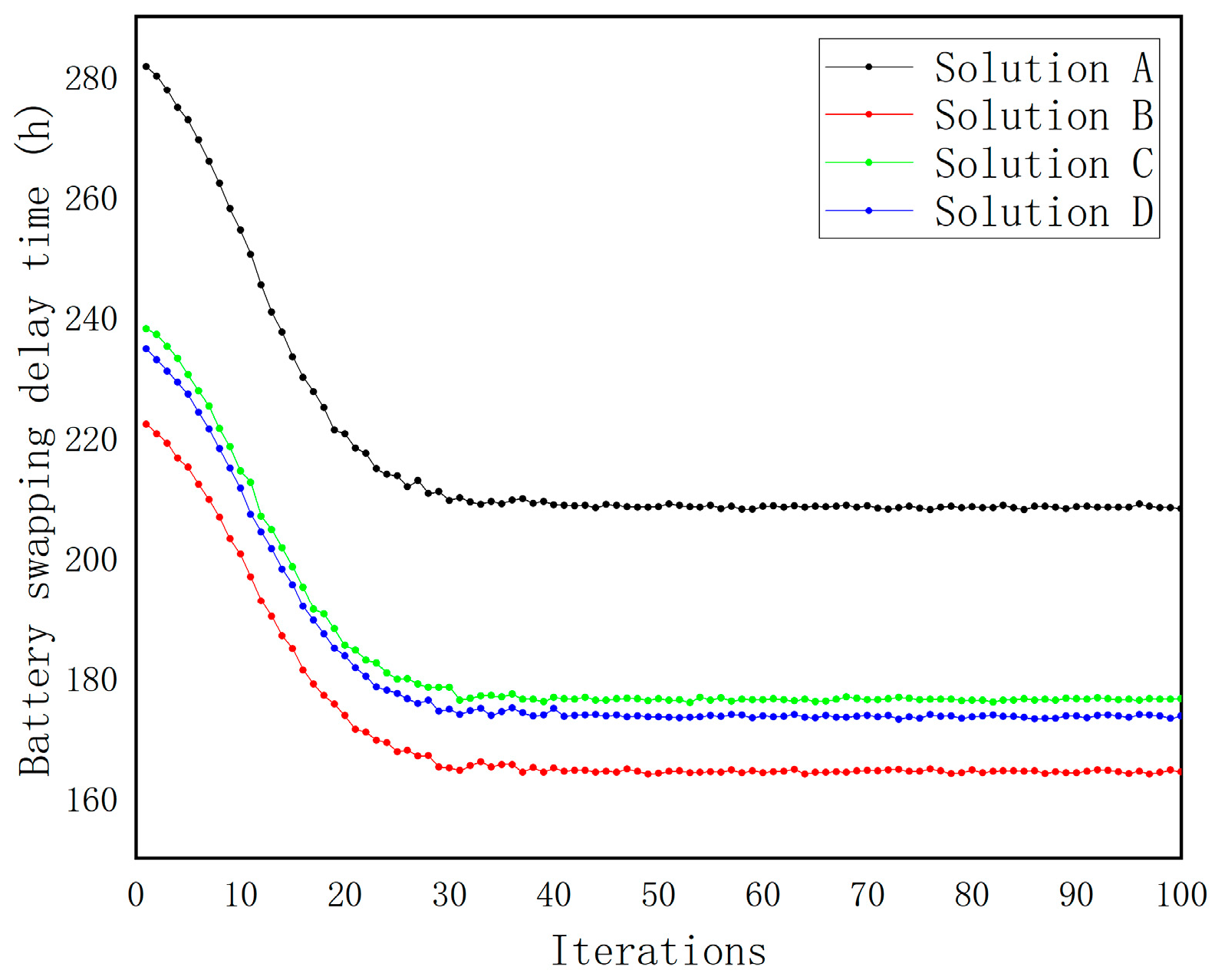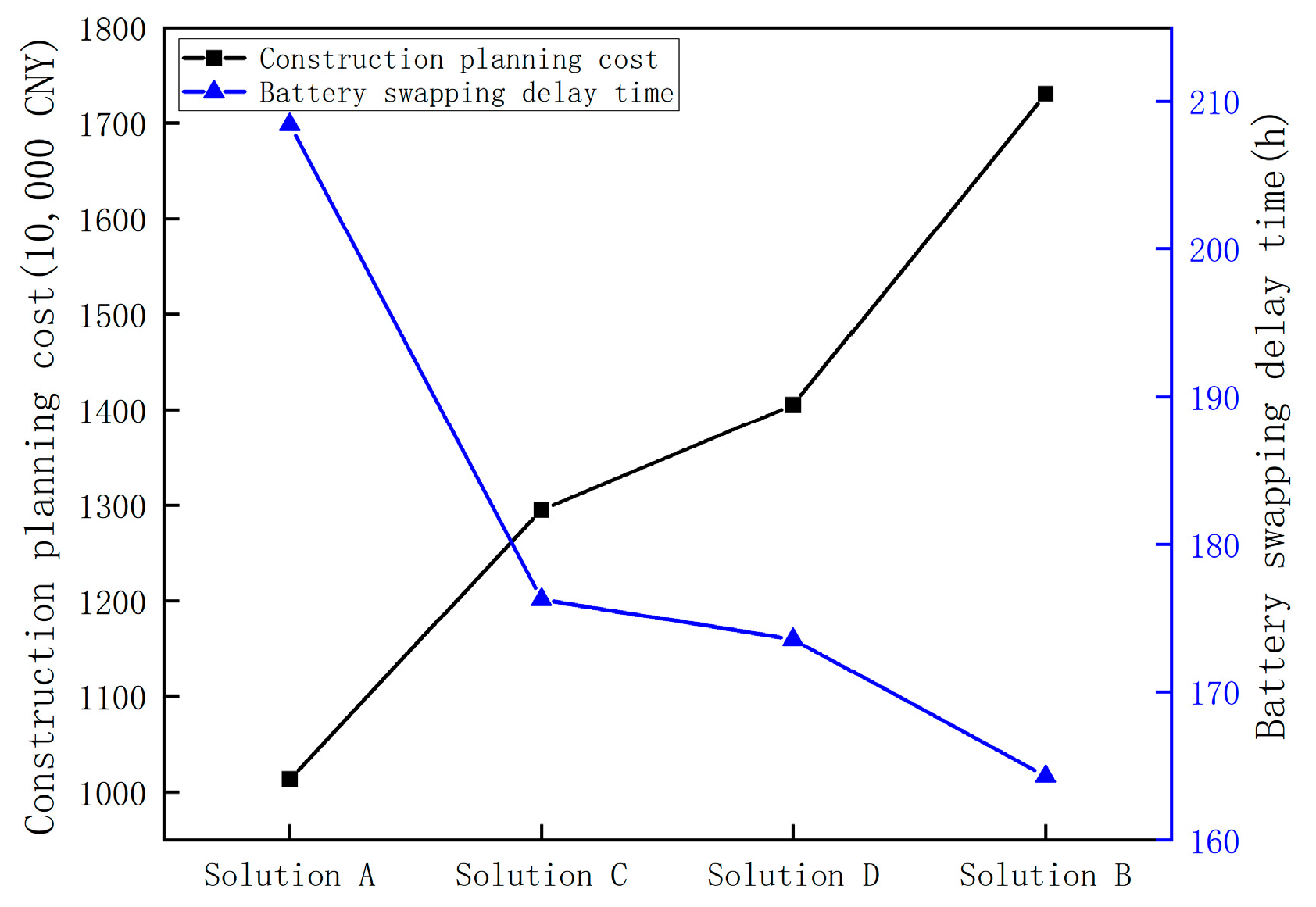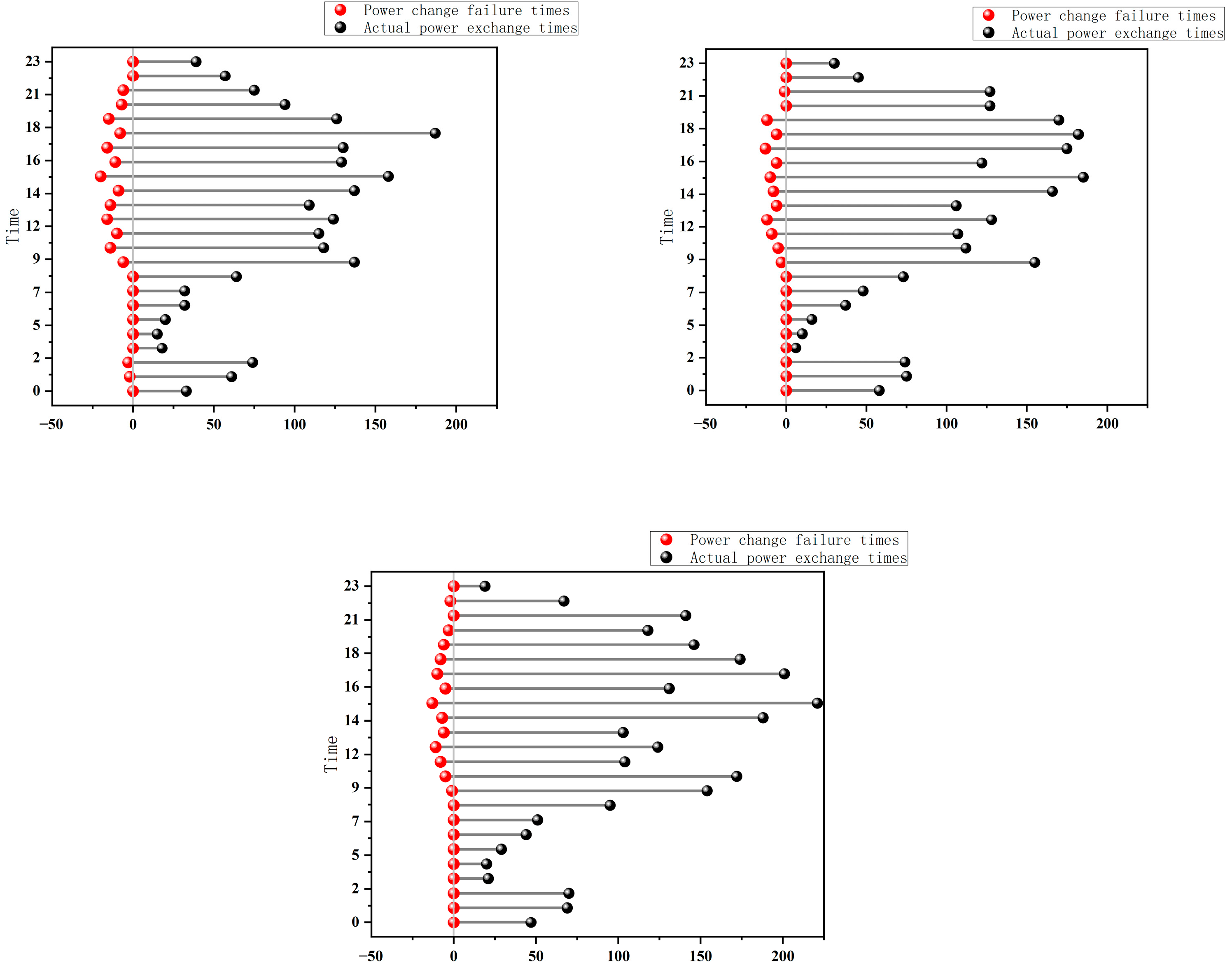4.2.4. Analysis of the Planning Results from the Integrated MLP-NSGA-II Site Selection Model
The analysis began with the Pareto non-dominated solution set obtained from the proposed method. Four representative solutions were selected from the set: (Solution A) the solution with the minimum construction cost, (Solution B) the solution with the shortest average battery swapping time, (Solution C) a balanced solution that achieves a trade-off between cost and efficiency, and (Solution D) a solution emphasizing structural diversity in spatial distribution. These four solutions reflect both extreme objective preferences and practical deployment diversity, allowing for comparative evaluation from different perspectives and application scenarios.
Table 6 presents the detailed construction locations and grade distributions of the stations for each solution. As shown in
Figure 10, the visualized result of the battery swapping station location plan is presented. In the figure, red solid triangles represent the final selected stations for construction, while red hollow triangles denote unselected candidate sites. The green dots in the background indicate the spatial distribution of battery swapping demand after grid-based processing. This figure intuitively illustrates the spatial relationship between candidate site selection and demand distribution.
The dynamic trends of planning and construction costs versus battery swapping time loss across 100 iterations for the four representative schemes are shown in
Figure 11 and
Figure 12. The specific convergence data are presented in
Table 7.
The results indicate that all four solutions experienced significant reductions in objective function values within the first 10 generations, reflecting a typical rapid convergence pattern. In Solution A, construction costs dropped swiftly from approximately CNY 1,372,000 to CNY 1,014,000. For Solution B, battery swapping delay time decreased from 222.17 h to 164.31 h, highlighting the optimization model’s high search efficiency in early iterations.
Solutions C and D also exhibited clear convergence. In Solution C, construction cost declined from CNY 1,813,000 to CNY 1,295,000, and swapping delay time from 208.95 h to 176.30 h, showing a smooth and stable trend. Solution D demonstrated strong robustness, with swapping delay time falling rapidly in the first 10 generations and stabilizing around 173.53 h after the 40th generation. Its construction cost also decreased steadily from CNY 1,907,000 to CNY 1,425,000, with minimal fluctuation.
Overall, the objective functions of all four solutions converged around the 40th generation, with only slight variations thereafter. This confirms that the integrated MLP-NSGA-II algorithm achieves both high optimization quality and fast convergence speed. Throughout the convergence process, local fluctuations of the objective values remained within a reasonable range. In particular, Solutions C and D demonstrated high stability in the middle and later stages, further validating the robustness and convergence performance of the proposed MLP-NSGA-II approach. The comparison of objective function values across different schemes is illustrated in
Figure 13.
The TOPSIS method was applied to comprehensively evaluate the ideality of the four representative solutions. Although Solution A excelled in cost control, its relatively low service efficiency resulted in a lower overall score. Solution B achieved the best performance in minimizing battery swapping delay time, but its significantly higher construction cost reduced its overall ranking. Solution D showed a more balanced performance, with a score of 0.72. Solution C demonstrated strong results in both objectives, achieving the highest composite score of 0.74, reflecting its excellent balance between construction cost and service efficiency.
Considering the performance and evaluation outcomes of all the solutions, this study ultimately selects Solution C as the recommended battery swapping station site selection plan based on the integrated MLP-NSGA-II optimization algorithm.
4.2.5. Comparative Analysis of Site Planning Results
In order to verify the superiority of the proposed MLP-NSGA-II joint optimization method, this paper selects the traditional genetic algorithm (GA) and the Density Peak Clustering (DPC) algorithm as the comparison method. Both of them are contrasted with the main model in terms of optimization idea, result expression, and applicability to verify the comprehensive performance of the main algorithm from multiple dimensions.
The genetic algorithm adopts a weighted sum approach to combine multiple objectives into a single-objective function for optimization. As a heuristic method, GA has been widely applied in complex combinatorial problems such as electric vehicle charging station location planning [
36,
37]. On the other hand, the Density Peak Clustering method, as an unsupervised clustering approach [
38], has been extensively used in urban spatial analysis and preliminary infrastructure site screening, representing an empirical siting strategy under non-optimization models. A comparison of the convergence curves for different algorithms is shown in
Figure 14.
The convergence curve demonstrates that the MLP-NSGA-II joint algorithm outperforms the traditional genetic algorithm (GA) in both optimization speed and convergence stability. The proposed method achieves convergence by the 30th iteration, with the objective function value stabilizing thereafter. In contrast, GA reaches a stable state at the 43rd iteration, indicating a convergence speed approximately 30.23% slower than MLP-NSGA-II. Additionally, the final fitness value obtained by GA is about 9.5% higher than that of the joint algorithm, reflecting inferior solution quality.
Figure 15 presents the optimal station siting schemes derived from the MLP-NSGA-II, GA, and DPC methods. For the DPC approach, supplementary constraints are introduced to regulate station scale and spatial layout. Specifically, the top seven cluster centers—selected based on demand density and spatial representativeness—are designated as station locations. To avoid excessive clustering and overlapping service areas, a minimum inter-station distance threshold is enforced. These adjustments align the DPC method with the optimization-based approaches in terms of station count and spatial distribution while preserving its intrinsic clustering logic.
Overall, the three approaches exhibit significant differences in site selection strategy, spatial distribution, and station hierarchy. As summarized in
Table 8, all the approaches select seven stations, yet their hierarchical configurations differ markedly. The MLP-NSGA-II scheme locates secondary stations near high-demand grids within the urban core, forming a “strong center response” layout that emphasizes service efficiency in dense areas. The GA method presents a more dispersed configuration, with some secondary stations positioned outside core zones, reflecting weaker demand alignment. The DPC method, while achieving broader spatial coverage, lacks hierarchical optimization; its station distribution along major roads limits allocation efficiency and reduces responsiveness to localized demand patterns.
To enable a fair comparison of the optimal site selection schemes from the three algorithms, two auxiliary indicators—service coverage and power exchange service utilization—were introduced in the post-evaluation stage. Since the DPC method does not optimize an explicit objective function, it cannot directly account for operational metrics such as power exchange time loss. These indicators allowed for a consistent evaluation of spatial coverage and service efficiency across all three methods, including MLP-NSGA-II and GA.
- (1)
The coverage ratio of power exchange service is the ratio of the number of power exchange demand points effectively covered by the service radius of a power exchange station to the total number of demand points. If the distance from a demand point to any power exchange station is less than the service radius of the power exchange station, it is considered to be covered, and the formula is as follows:
where
denotes the set of switching demand points,
denotes the switching demand points, and
denotes the set of switching station sites.
The corresponding power exchange service coverage for each scenario is shown in
Figure 16. In this case, each diagram is centered on the built site, the service coverage area is plotted according to the service radius set by the site level, and the location of all power exchange demand points is superimposed.
Table 9 presents the number of demand points covered by each scheme under the service radius constraint. The coverage rates for the MLP-NSGA-II, GA, and DPC methods are 94.30%, 88.96%, and 82.19%, respectively. Among them, the MLP-NSGA-II scheme achieves the highest coverage, with only 154 demand points remaining uncovered. This indicates a more spatially balanced station layout, effectively targeting high-density demand clusters. The GA method ranks second, though it still exhibits partial service gaps in lower-density or peripheral areas. In contrast, the DPC approach yields the lowest coverage rate; its stations are primarily concentrated along major urban roads, resulting in dense coverage within central clusters but limited spatial reach toward peripheral zones, reflecting poor service scalability.
- (2)
The utilization rate of power exchange service , which is the ratio of the actual number of completed power exchanges of the power exchange station to its theoretical maximum service capacity under the specified service capacity limit, reflects the utilization efficiency of the station’s resources in all-day operation, and is calculated by the formula:
where
is the number of services actually completed throughout the day and
is the maximum daily service capacity of the site
.
The results of planning and construction cost and switching service utilization of different algorithmic optimal siting schemes are shown in
Table 10. Meanwhile, combining with the simulation of switching service allocation, the distribution of switching service states of each algorithmic optimal scheme under all-day operation conditions is derived, as shown in
Figure 17.
Comparing the coverage and utilization rates of the different schemes, the joint optimization strategy based on MLP-NSGA-II shows the best overall performance, with a service coverage of 94.30%, which is 12.11% higher than that of DPC, and a service utilization rate of 85.35%, which is 6.25% and 19.69% higher than that of GA and DPC, respectively. The results show that the MLP-NSGA-II scheme is more coordinated in terms of station hierarchy, spatial layout, and load matching, and has the best service efficiency; the GA method is the second best; and the DPC method has the lowest service utilization rate, reflecting that there is significant room for improvement in spatial allocation and resource regulation.
The above analysis shows that under the constraints of the same construction scale and the number of stations, the joint optimization strategy based on MLP-NSGA-II is able to reasonably configure the primary and secondary power exchange stations on the basis of fully considering the spatial structure of the city and the distribution of the power exchange demand, realizing the hierarchical response of the core and peripheral areas, and effectively improving the utilization efficiency of the station’s service capacity and the overall service completion rate, and showing better service efficiency and overall service completion rate in the siting problem of the power exchange station. It effectively improves the utilization efficiency of station service capacity and the overall service completion rate, and shows better global performance and application potential in the siting problem of power exchange stations.



